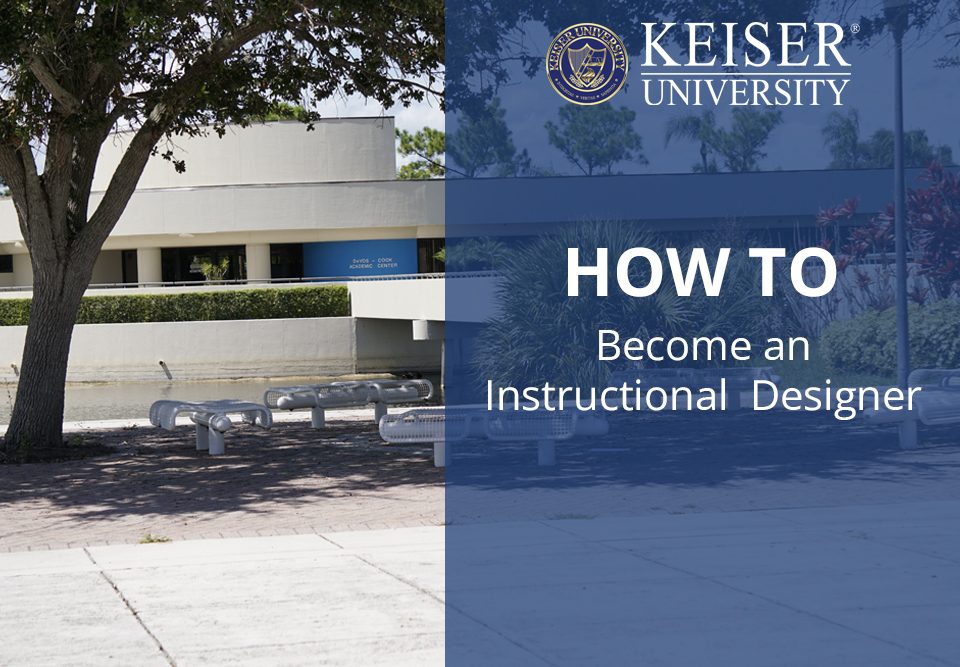Education continues to evolve thanks to technological advances and the way humans learn. With changes in so many facets of life, educational professionals understand that the approach to instruction must also change. It is crucial to ensure that today’s students and tomorrow’s leaders have equally evolving and sufficient education to thrive and lead future generations, making instructional design an essential discipline.
According to the Bureau of Labor Statistics (BLS), the prospects for instructional designers (sometimes called instructional coordinators) are promising, with a projected 7% growth from 2021 through 2031. This faster-than-average growth rate means a bright future for any dedicated university student deciding to pursue a career as an instructional designer.
If you are a student considering a graduate degree in instructional design, we want to offer some insights to help you cultivate a career path to help future students successfully.
What Is Instructional Design?
According to Keiser University’s Dean of Graduate Studies, Ashlee Robertson-Arduengo, the instructional design discipline concerns the methods, theories, and technology to build good instruction. It started as a branch of the military designing training simulations for their soldiers and has become a popular branch within all types of education.
Whether developing training, professional development or creating an online course for a university or K12 education, instructional design combines the practical aspects of taking a curriculum and designing it so that the instruction comes across for the learners. It’s the crossroads between instruction and technology to achieve the best possible learning outcome.
This definition gives us a great place to start and expand our discussion of instructional design, a process intended to design, develop, and deploy the latest learning products and experiences in various educational areas from subject matter experts.
Learning design products include:
- Online courses and online learning experience
- Instructional manuals
- Video tutorials
- Learning simulations
Professionals in instructional design serve as “architects” set to plan and enhance the modern learning paradigm and as “directors” of the instructional design process. You might encounter several terms used interchangeably in this field:
- Instructional design
- Instructional technology
- Learning experience (LX) design
- Curriculum design
- Instructional systems design (ISD)
What Is an Instructional Designer?
As educational and instructional experts continue innovating and discovering more findings in the field, instructional designers work to use those findings to develop easily digestible educational materials for students. They work to refine, revise, and adapt innovations into meaningful instruction in the best format and delivery system.
However, as you might imagine, instructional design is more complex than revising and updating textbooks or adding new information to an existing course. Instructors must look at the entire learning process to see how it needs to be reimagined and reshaped, weaving together new and existing information.
This is why the role of an instructional designer is so crucial to the process. These professionals take the existing and new information and work to redesign instruction. They develop complete curriculums and courses and create the necessary accompanying learning materials in appropriate delivery systems and formats while providing intensive teaching manuals and student guides to ensure optimal understanding and ultimate success for everyone.
The responsibilities of instructional coordinators include focusing on “the theory and practice of design, development, utilization, management, and evaluation of processes and resources for learning.”
Instructional designers take new information and implement theory and the appropriate research processes to design and develop learning materials that benefit student learning and help produce better outcomes for a specific group of learners, depending on the learning discipline.
Benefits of Becoming an Instructional Designer
If you are considering becoming an instructional designer, it is essential to understand the benefits awaiting you in this exciting and fast-growing discipline. It is a fascinating field, full of exciting work to ensure today’s and tomorrow’s students are learning the most up-to-date information to spur continuous and dynamic learning design.
Let’s look at some benefits and your place in this field.
Advantages for Learners
Instructional designers ensure that students are learning only the most current and relevant information specific to the field to which they study, which is essential in today’s fast-paced world.
There are more advantages, including:
- Better Learning Opportunities: Better and more engaging learning opportunities abound for learners studying in an instructional design-supported learning environment. Instructional design provides a framework for instructors to learn more about students and how they learn. It allows educators to identify the knowledge and skills students must demonstrate by the end of the course, ensuring they have met their learning goals and desired outcomes.
- Continually Improving Course Materials and Information: As an instructional coordinator, you can continually improve your program’s quality from the first class to the final exam. By providing well-defined learning goals, you ensure a high-quality learning experience for eager students investing their time, money, and future professional prospects in your course.
- Students Offer Feedback for Continuous Improvement: Letting students’ voices be heard about the programming is crucial to your success in instructional coordination. By offering assessments and welcoming feedback, instructional designers and faculty gain insights into areas that would benefit from meaningful improvements in an online learning program.
Advantages for Instructors
Educators and instructors at every level need guideposts to ensure they are serving their students in online class environments. Your work in instructional design offers an efficient and cost-effective way to ensure they deliver high-quality information and materials in the appropriate formats, taking into account the students’ learning styles, strengths, and weaknesses.
Advantages for Organizations
The academic landscape is competitive, so your instructional design work can help colleges and universities maintain optimal quality control. With your input, they can ensure that their faculty has access to the latest world-class learning materials and techniques for each discipline they offer, from undergraduate to master’s degree programs and beyond.
Your online learners and their families will appreciate your work, which will reflect well on the academic facility too, so everyone wins through your efforts in this field.
Rising Demand and Need
The impact of the COVID pandemic is widespread and ongoing. In many cases, it has spurred businesses and universities to continue pursuing greater tiers of excellence to match growing and changing technology. The online learning design field is crucial to learning and working in the post-pandemic reality.
Ashlee Robertson-Arduengo at Keiser University believes online learning and instructional design are here to stay, noting that during the pandemic, K12 and higher education institutions relied on online learning options. Because of that experience, more universities than ever are going online and have come to appreciate the utility of online courses.
As noted earlier, the demand for instructional designers is predicted to grow by 7% over the next decade, especially in light of the increasing online educational opportunities for students at all levels who need the most current information and materials to prepare them for an ever-evolving future.
Salary Opportunities
The financial prospects for instructional coordinators are promising. As of May 2021, the median annual salary for instructional designers was $63,740. However, with the varied opportunities in academia and the business world, you could stand to earn substantially more. ZipRecruiter reports earnings as high as $133,000 annually.
Instructional Design Is a Fascinating and Evolving Field
Finally, instructional design is an exciting and growth-oriented field. Instructional design is especially interesting because it’s not only useful in the realm of education. Businesses and corporations need help designing training programs; human resources departments need to create workshops for their employees; health insurance companies hire instructional designers to produce educational or informational materials. The possibilities of how you could utilize your training in instructional design are nearly endless, and a master’s degree in instructional design offers unlimited, dynamic potential career prospects.
How to Become an Instructional Designer
Once you decide that this fascinating field is the right career path for you, there are some practical things you can do to prepare for success. Whether you choose to pursue an education specialist degree in instructional design and technology, a Master of Science in Educational Instructional Design Technology, or an online PhD in Instructional Design and Technology, there are some crucial steps you can take for success.
1. Leverage Your Experience
Leverage your experience as an undergraduate student in education or another discipline. Take your foundational expertise, find a way to add value to other students in this discipline by learning more about it. You may even decide to base your instructional design studies and future career on it.
2. Learn Instructional Design and Technology
There are several educational pathways to studying instructional design at the PhD, master’s, and EdS levels.
Let’s look at each degree type and what it has to offer:
- PhD: PhD programs focus on instructional design as a researcher’s degree and are intended for those planning to teach in higher education. It is more of a scholarly pursuit than a practical pathway toward a career as an instructional coordinator.
- Master’s: A master’s degree program is what students focused on becoming instructional designers tend to pursue. It is the degree that a lot of businesses and universities seek in students right now. It is more of a practitioner’s program than a philosophical study, offering foundational philosophies and practical skills and approaches to give instructional design students the full picture and practical methodologies to put their education into practice.
- EdS: An Education Specialist Degree program for instructional design allows students to contribute to the education profession in a meaningful way through independent learning and scholarship. In this program, you can learn how to evaluate and apply current instructional design best practices for the course, program, and training development, develop and revise instructional design expertise, and much more.
3. Start Your New Career!
Start your new career in instructional design through a few strategies, including:
- Work as an apprentice to develop a portfolio of your experience and work product.
- Network with professors, educators, and business leaders to determine where the opportunities are and how you might help their educational facilities or businesses.
- Apply to your ideal academic institutions and businesses to share your interest and experience with them.
Become an Instructional Designer with Keiser University
Are you ready to plot your course as an instructional designer? Our team at Keiser University is here to help you achieve your educational and professional goals. Whether you are interested in our doctoral, master’s, or educational specialist studies in this area, we can help you find the best path for your success and the learners you will help in the future.
Learn more about our graduate degrees today, and reach out to us with any questions you might have. We look forward to hearing from you!






 The instructors at Keiser University impacted my life. They believed in my ability to become a great graphic designer, regardless of how I felt about my skills. KU helped to prepare me for the real world and got me to where I am today.
The instructors at Keiser University impacted my life. They believed in my ability to become a great graphic designer, regardless of how I felt about my skills. KU helped to prepare me for the real world and got me to where I am today.
